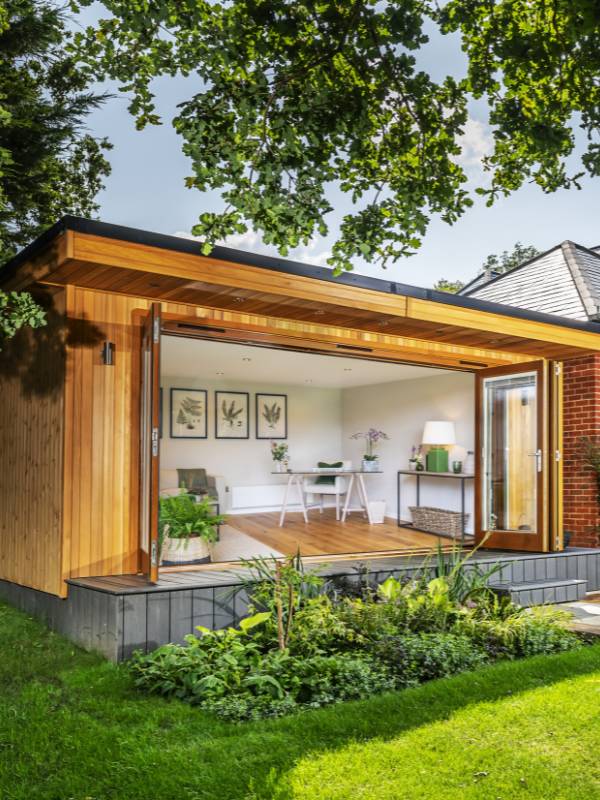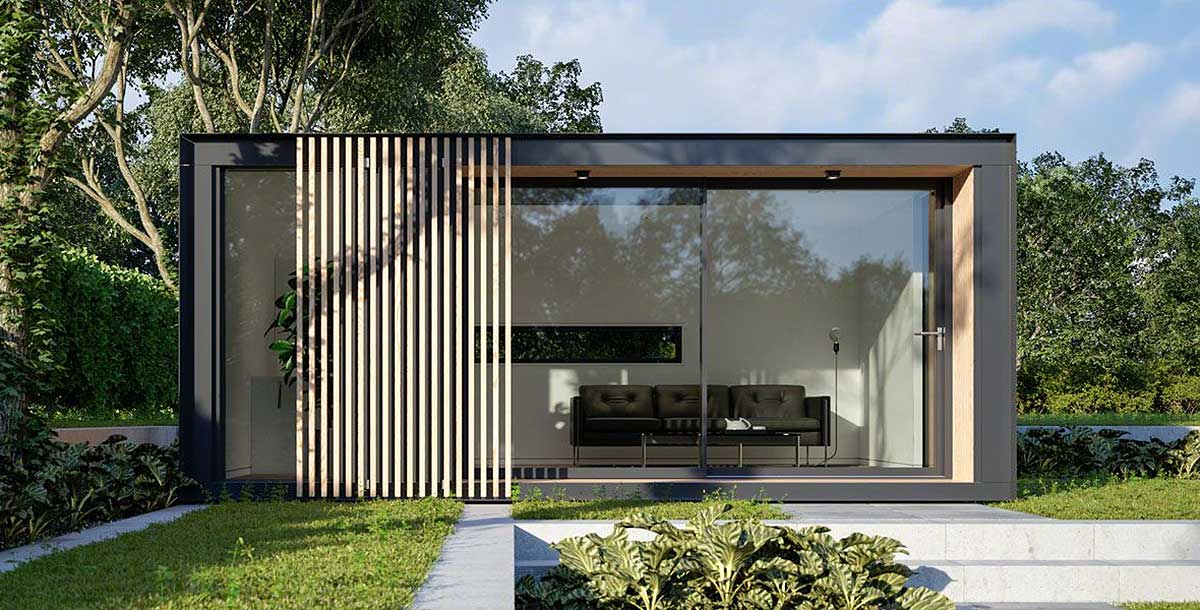There are certain restrictions that are required for the construction of conservatories or garden rooms, outhouses or garden offices within conservation areas. These restrictions aim to protect the look and feel of these areas. Here are the key factors to consider when planning permission is granted within conservation zones: General Restrictions:
A conservation area may require approval for planning for any structure extension, addition or any other construction which is normally covered by permitted development rights. This includes sheds, garden rooms and outbuildings.
Size and Scale
Planning permission is required for any structure, regardless of its size if it alters the nature of the conservation area. Buildings that are new or extensions to designated zones are subject to more stringent rules.
Location:
The likelihood of a property that requires planning permission rises if the building or extension is situated on the front, side, or back. Planning permission is needed for rear structures when the structure is visible from public places or affects the general character.
Materials and Design
Design and material selection is essential in conservation areas. A new extension or building should use materials that are compatible with the historical or architectural interest of the area. This will require planning permission.
Demolition:
To ensure that any changes made to the zone are not detrimental to its character The planning permit is required for demolitions of existing or part of existing structures, for instance outbuildings and boundary walls.
Height Restrictions:
In conservation areas there are stricter restrictions on height. Anything that is over 2.5 meters in height (especially within two metres of the boundary line) is likely to require approval for planning.
Impact on Surroundings:
Planning permission is required when the extension or construction is likely to impact the appearance or visual setting of the Conservation Area, in addition to the views that pass through and exit the Conservation Area.
Building Use:
Planning permission might be required regardless of whether the garden area or outbuilding is within permitted dimensions. This could result from changes in the usage of the property.
Changes to the original design:
Planning permission is usually required for extensions that exceed the specified size or volume limits or alter the exterior appearance. This applies to conservatories as well as other significant changes.
Curtilage Structures:
Planning permission is required for structures within the boundaries of the conservation zone. This includes expansions, new outbuildings or modifications.
Protected trees
Trees are protected within conservation areas. In the event that your proposed construction will impact trees, you might need to obtain additional permissions including a tree work consent and a planning permit.
Local Authority Guidelines
Local planning authorities can establish particular guidelines to govern conservation areas. These guidelines can be adapted to suit the unique nature and character of each area.
Planning permission is required in conservation areas. This involves an extensive evaluation of the impact the proposed extension, garden room, outhouse, conservatory or garden office will have on the historic and architectural characteristics of the location. To ensure that the project meets all relevant laws, it is essential to talk with your local authorities before beginning the planning process. See the top rated ground screws vs concrete for more tips including composite garden office, costco garden room, garden room permitted development, insulated garden buildings, how to lay decking on soil, costco garden office, costco garden rooms, garden rooms brookmans park, myouthouse, garden room permitted development and more.

What Planning Permission Is Required For Gardens, Rooms Etc. In Relation To Neighbourhood Concerns?
If you plan to build conservatories, garden offices outhouses, garden offices or outhouses The concerns from your neighbors will determine the need for planning permission. Here are some important aspects to consider privacy and overlooking:
A planning permit is required if a new building may result in a loss of privacy due to the view of neighboring properties. This is so that the new building doesn't adversely affect the living environment of those living close to.
Overshadowing or Loss of light:
If the proposed building could overshadow or result in a substantial reduction in light to neighboring homes, planning permission might be required. The local planning authority will decide the effect of the proposed development on daylight and sunlight in nearby properties.
Noise and Disturbance
The planning permission is necessary if the garden or extension is planned being used for noise-generating activities (such as clients visiting your office at home or a music studio, an office, etc.). This ensures that the sound levels are acceptable and do not disturb the neighborhood.
Visual Impact and Character
The design, size and design of the building must be in line with the character of the neighborhood. Planning permission is required to ensure that the new construction is attractive and doesn't compromise the aesthetics of the neighborhood.
Boundary Proximity:
If the structures are higher than 2.5 meters and are located within 2 meters of the property line the planning permission is required. This is in order to prevent disputes and impacts on neighboring properties.
Shared Access Rights of Way and Rights of Way
If the construction affects shared access points or rights of way Planning permission is required to ensure that these aren't blocked or impact.
Restrictions of neighbors
Residents living near each other are entitled to be informed about planning applications. Planning authorities consider objections of neighbours when deciding if permission is granted.
Property values are affected by the impact of this.
Although it's not always the main aspect, any major changes to homes which could impact the value of their properties could affect the need for an approval. The impact of these changes will be considered by the local authorities in making their decision.
Covenants and Deed Restrictions
If you have a deed restriction or covenant for your property, it could require you to adhere to these, regardless whether planning permission is granted. These agreements could limit the types of structures that can be built, and impact the harmony of the neighborhood.
Construction Disturbance:
A planning permit may be granted to address issues regarding disruptions that is caused by construction like dust, noise, or traffic. Conditions may be imposed to limit the impact on neighbours.
Infrastructure Impact
If the structure is causing additional strain on local infrastructure (e.g. drainage, parking, road usage), planning permission ensures that the impacts are analyzed and addressed accordingly.
Community Consultation
In some instances there are occasions when a larger community consultation may be required, particularly in the case of more complex or controversial developments. It allows for a democratic process of decision-making because it takes the opinions of the local community into account.
In conclusion, the neighborhood's concerns play a significant role in the process of receiving planning permissions for conservatories and garden rooms. Ensuring that the proposed development doesn't alter the living space as well as lighting, privacy, noise levels, or the overall appearance of the neighborhood is vital. Consulting with the neighborhood planner and involving neighbors early in the process of planning can help to solve these issues and lead to more easily granting approval. Check out the best composite cladding garden room for site recommendations including garden outhouses, garden rooms near me, costco outbuildings, conservatories and garden rooms, ground screws vs concrete, outhouse uk, my outhouse, out house for garden, garden room conservatory, garden rooms near me and more.

What Planning Permission Do You Need For Garden Rooms Etc.?
The design and appearance of the building will determine whether or not planning permission is needed to build conservatories, garden offices and outhouses as well as garden rooms. These are the most important considerations:
Planning permission is not required if you are able to construct the structure within permitted development rights of your property. However, certain requirements are required with regard to appearance and design.
Size and Scale
The size and scale of the new building should be proportional to the existing structure and the adjacent buildings. If the structure is larger than the size allowed, planning approval is required.
Height and Massing
The mass and height of the new structure must be in line with the size of the property as well as surrounding structures. Typically it is necessary to obtain planning permission when structures over the limit of height or are not in scale with the area surrounding it.
Materials and Finishes:
The material and finish should be in harmony with the surroundings. The materials chosen may need approval from the planning authority when they do not fit in with the character with the surrounding buildings.
Design Harmony
The design and style of the building must match the architecture of the existing structure. If the design proposed is not compatible with the local character and appearance, planning permission will be required.
Roof Design
The roof's design must match the style of the surrounding property and buildings. Planning permission may be required if a proposed roof design is not keeping with the local character and appearance.
Fenestration, Windows and Doors:
The design and placement of doors and windows should match the home and the surrounding area. Planning permission might be needed when the proposed fenestration isn't in harmony with the local style and appearance.
Facade Treatment:
The treatment of the facade should be harmonious with the surrounding properties as well as existing buildings. The proposed facade could require approval for planning if it is incompatible with the building around it.
Landscaping & Surroundings
The landscaping for the building around it must be in line with the existing structures as well as the property. Planning permission could be required if the landscaping isn't in line with the local style and appearance.
Visual Impact
The visual impact of the new structure on the surrounding area should be limited. Planning permission may be needed if the proposed structure has an adverse visual impact on the area.
Heritage and Conservation Areas
It is possible that more stringent specifications for design and appearance are in place if your home is situated within a heritage or conservation zone. A planning permit may be required to build structures that meet the criteria.
Architecture and Guidelines for Planning
Local planning authorities often issue aesthetic and design guidelines. The structure may need planning permission in the event that it doesn't follow these guidelines.
The style and appearance of the design is usually the main factor in determining whether planning permission is granted for conservatories or garden rooms. Check with the local authority for planning as early as possible in the planning phase to ensure that the design conforms to the local aesthetic and character guidelines, and also to determine if planning permission is needed. View the best garden conservatory for blog tips including insulated garden buildings, garden buildings , 4m x 4m garden room, do i need planning permission for a garden room with toilet, outhouse for garden, 4m x 4m garden room, outhouses for garden, outhouses, costco garden buildings, 4m x 4m garden room and more.
